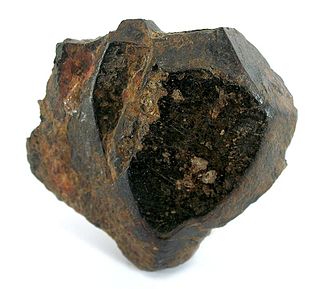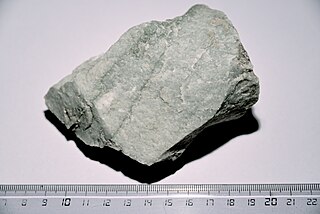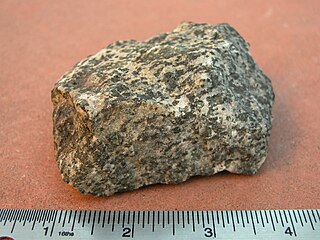Related Research Articles

Titanium is a chemical element with the symbol Ti and atomic number 22. Found in nature only as an oxide, it can be reduced to produce a lustrous transition metal with a silver color, low density, and high strength, resistant to corrosion in sea water, aqua regia, and chlorine.

Ilmenite is a titanium-iron oxide mineral with the idealized formula FeTiO
3. It is a weakly magnetic black or steel-gray solid. Ilmenite is the most important ore of titanium and the main source of titanium dioxide, which is used in paints, printing inks, fabrics, plastics, paper, sunscreen, food and cosmetics.

Sokndal is the southernmost municipality in Rogaland county, Norway. It is located in the traditional district of Dalane. The administrative centre of the municipality is the village of Hauge. Other villages in Sokndal include Li, Rekefjord, Sogndalsstranda, and Åna-Sira.

Cryolite (Na3AlF6, sodium hexafluoroaluminate) is an uncommon mineral identified with the once-large deposit at Ivittuut on the west coast of Greenland, mined commercially until 1987.

Titanium dioxide, also known as titanium(IV) oxide or titania, is the inorganic compound with the chemical formula TiO
2. When used as a pigment, it is called titanium white, Pigment White 6 (PW6), or CI 77891. It is a white solid that is insoluble in water, although mineral forms can appear black. As a pigment, it has a wide range of applications, including paint, sunscreen, and food coloring. When used as a food coloring, it has E number E171. World production in 2014 exceeded 9 million tonnes. It has been estimated that titanium dioxide is used in two-thirds of all pigments, and pigments based on the oxide have been valued at a price of $13.2 billion.

Quartzite is a hard, non-foliated metamorphic rock which was originally pure quartz sandstone. Sandstone is converted into quartzite through heating and pressure usually related to tectonic compression within orogenic belts. Pure quartzite is usually white to grey, though quartzites often occur in various shades of pink and red due to varying amounts of hematite. Other colors, such as yellow, green, blue and orange, are due to other minerals.

Jøssingfjorden is a fjord in Sokndal municipality in Rogaland county, Norway. The 3-kilometre (1.9 mi) long fjord is narrow and deep and is surrounded by mountains. It sits about 4 kilometres (2.5 mi) southeast of the municipal centre of Hauge. There is some settlement on the southeastern side of the fjord: the villages of Li, Vinterstø, and Bu. There is a road that runs along the southeast coast of the fjord, with sharp hairpin turns leading down from the mountains to the shore of the fjord both heading north and south from the fjord.

Norite is a mafic intrusive igneous rock composed largely of the calcium-rich plagioclase labradorite, orthopyroxene, and olivine. The name norite is derived from Norge, the Norwegian name for Norway.

Sodium aluminium hexafluoride is an inorganic compound with formula Na3AlF6. This white solid, discovered in 1799 by Peder Christian Abildgaard (1740–1801), occurs naturally as the mineral cryolite and is used extensively in the industrial production of aluminium metal. The compound is the sodium (Na+) salt of the hexafluoroaluminate (AlF63−) ion.
Titanium mining in Africa has been beset by environmental problems due to the polluting nature of processing rutile, a principal titanium ore. Titanium production in Africa includes the following principal countries and companies.

Geological Survey of Norway, abbreviation: NGU, is a Norwegian government agency responsible for geologic mapping and research. The agency is located in Trondheim with an office in Tromsø, with about 200 employees. It is subordinate to the Norwegian Ministry of Trade, Industry and Fisheries.
Tinfos is a private Norwegian holding company. Its roots dates back to 1875, and has today the head office in Oslo, Norway. The firm is one of the oldest companies in its field of activity in Europe. Its main products are silicomanganese, High Purity Pig Iron and titanium dioxide. The company is structured in 4 different divisions. Tinfos AS was sold 15 April 2008 to the French-based manganese company Eramet. In 2009, Eramet sold the international unit of Tinfos to Holta Invest AS, a Norwegian investment company.
Titania may refer to:

Ødegården Verk, alternate names Ødegården Apatittgruver and Bamble Apatittgruver, was a series of primarily apatite shaft mines and quarries located in the Bamble municipality of Norway. At its peak, Ødegården Verk was one of the largest apatite mines in the country, mining up to 10,000 metric tons of the mineral per year, and some sources estimate its peak operating workforce at over 800 men.
The Engebø mine is one of the largest titanium mines in Norway. The mine is located in Sogn og Fjordane. The mine has reserves amounting to 154 million tonnes of ore grading 3.8% titanium.

The Tellnes mine is one of the largest titanium mines in Europe. The mine is located about 4 kilometres (2.5 mi) northeast of the Jøssingfjorden in Sokndal municipality in Rogaland county, Norway. The mine has reserves amounting more than 300,000,000 tonnes of ore grading 18% titanium. The deposit of titanium was discovered in 1954 and production at the mine began in October 1960. Each year there is about 2,000,000 tonnes of ore and 1,600,000 tonnes of rock waste removed from the open-pit mine. This resulted in about 580,000 tonnes of ilmenite concentrate from the mine in 1999.
The Kodal mine is one of the largest titanium mines in Norway. The mine is located in Vestfold. The mine has reserves amounting to 70 million tonnes of ore grading 8% titanium.
The Rødsand mine is one of the largest titanium mines in Norway. The mine is located in Møre og Romsdal. The mine has reserves amounting to 131 million tonnes of ore grading 4% titanium.
The Selvåg mine is a titanium mine in Norway. The mine is located in Kobbvågfjellet, Langøya, Nordland and has reserves amounting to 44 million tonnes of ore grading 2.5% titanium.
The Engebøfjell mine is one of the largest titanium mines in Norway. The mine is located in Sogn og Fjordane. The mine has reserves amounting to 400 million tonnes of ore grading 4% titanium.
References
- ↑ "Faktarka for Forekomstområde 1111 - 008". aps.ngu.no. Retrieved 2021-01-24.
- ↑ Korneliussen A, McEnroe SA, Nilsson LP, Schiellerup H, Gautneb H, Meyer GB, and Størseth, LR. (2000). "An overview of titanium deposits in Norway" (PDF). NGU Bulletin. 436: 27–38.
{{cite journal}}: CS1 maint: multiple names: authors list (link)